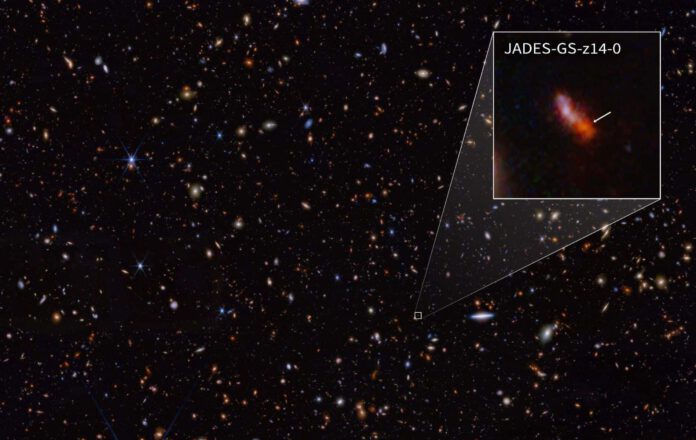
The farthest galaxy, which existed just 300 million years after the Big Bang, is remarkable not only because of its age but also due to its size and brightness.
Exploring the Cosmic Dawn
In recent years, scientists have utilized the powerful James Webb Space Telescope to investigate what astronomers refer to as the ‘Cosmic Dawn’—the period within the first few hundred million years after the Big Bang during which the earliest galaxies were born. These galaxies provide crucial information about the development of gas, stars, and black holes in the infancy of the universe. Now, researchers come with significant news. Thanks to the telescope’s sharp vision, a new research team has discovered the two earliest and most distant galaxies ever seen.
Breaking Records
The two record-breaking galaxies are named JADES-GS-z14-0 and JADES-GS-z14-1, with the former being the farthest. This galaxy dates back to merely 300 million years post-Big Bang. “In January 2024, we observed the galaxy JADES-GS-z14-0 for nearly ten hours,” the researchers explain. “When the spectrum was first analyzed, there was unmistakable evidence that the galaxy had a redshift of 14.32, breaking the previous record for the most distant galaxy.”
Besides setting a new distance record, JADES-GS-z14-0 is remarkable for its size and brightness. Images reveal that the source spans more than 1600 light-years. “The size of the galaxy clearly indicates that most of the light is from a significant number of young stars, not material falling into a supermassive black hole at its center, which would appear much smaller,” explains researcher Daniel Eisenstein. This amount of starlight suggests the galaxy is hundreds of millions of times more massive than the Sun. This raises a pressing question: how can nature form such a bright, massive, and large galaxy in less than 300 million years?
Unexpected Discoveries
The extraordinary brightness of JADES-GS-z14-0, powered by young stars, makes it the most striking evidence to date for the rapid formation of large, massive galaxies in the early universe. This contradicts astronomers’ expectations since the discovery of thus far unseen early bright galaxies challenges existing theories of galaxy formation. “It is astonishing that the universe could create such a galaxy in just 300 million years,” says lead researcher Stefano Carniani.
Hydrogen and Oxygen
Moreover, what stands out about this galaxy is its surprising brightness at mid-infrared wavelengths. This indicates the emission of hydrogen and even oxygen atoms in the early universe. “Even though it is so young, the galaxy is already actively producing the elements we know on Earth,” notes researcher Zihao Wu. It is very surprising to find oxygen so early in this galaxy’s life. This suggests that several generations of very massive stars have already formed and died before researchers observed the galaxy.
A Milestone
The results mark a significant milestone in exploring the early universe. “This remarkable object demonstrates that galaxy formation in the early universe occurs very quickly and intensely,” concludes co-author Ben Johnson. “And James Webb will help us discover more of these galaxies, perhaps even when the universe was even younger. It offers a fantastic opportunity to study how galaxies form.”
Researchers are looking forward to finding even more extraordinary early galaxies. Considering the relatively small area they examined to find JADES-GS-z14-0, they believe many more similar galaxies are waiting to be discovered. “The discovery has significant implications for the number of bright galaxies we expect to see in the early universe,” the researchers write. “Astronomers will likely discover many more bright galaxies, maybe even earlier in time. We look forward to uncovering the extraordinary diversity of galaxies that existed during the Cosmic Dawn!”











